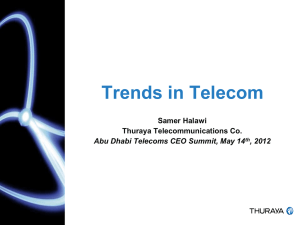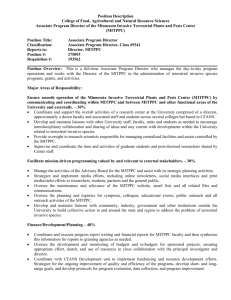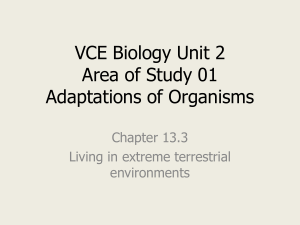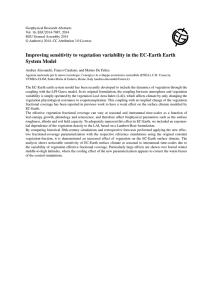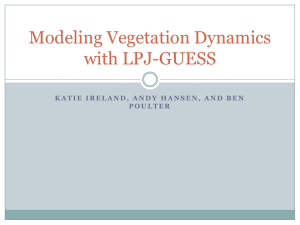Hydrologic and Biogeochemical Fluxes in Land
advertisement
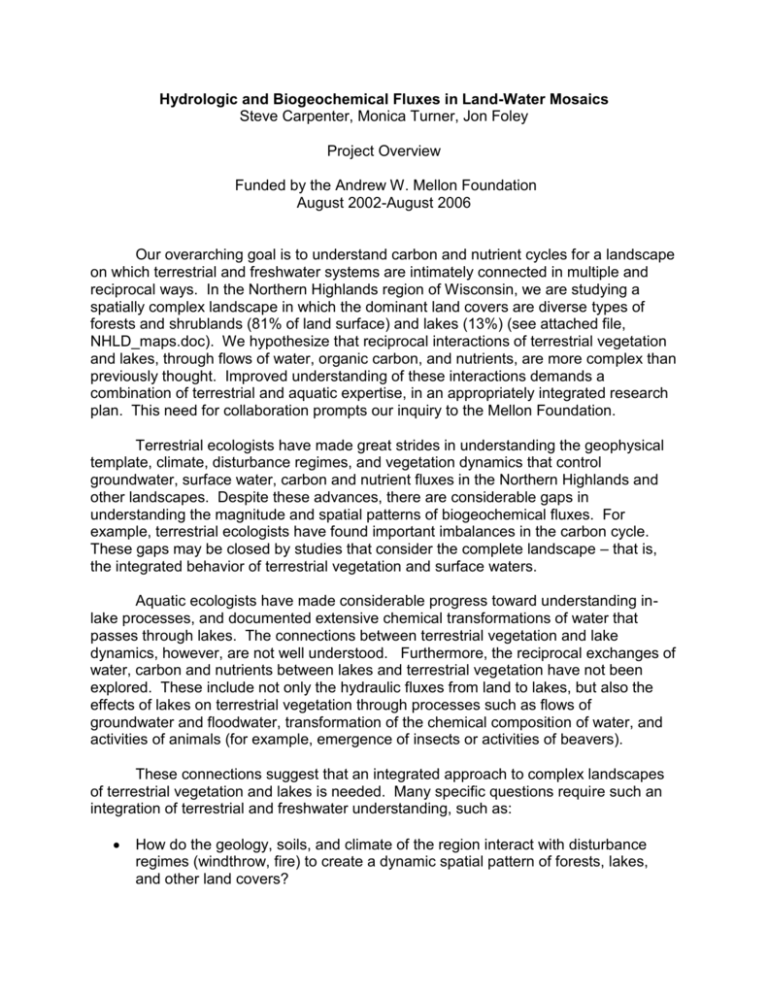
Hydrologic and Biogeochemical Fluxes in Land-Water Mosaics Steve Carpenter, Monica Turner, Jon Foley Project Overview Funded by the Andrew W. Mellon Foundation August 2002-August 2006 Our overarching goal is to understand carbon and nutrient cycles for a landscape on which terrestrial and freshwater systems are intimately connected in multiple and reciprocal ways. In the Northern Highlands region of Wisconsin, we are studying a spatially complex landscape in which the dominant land covers are diverse types of forests and shrublands (81% of land surface) and lakes (13%) (see attached file, NHLD_maps.doc). We hypothesize that reciprocal interactions of terrestrial vegetation and lakes, through flows of water, organic carbon, and nutrients, are more complex than previously thought. Improved understanding of these interactions demands a combination of terrestrial and aquatic expertise, in an appropriately integrated research plan. This need for collaboration prompts our inquiry to the Mellon Foundation. Terrestrial ecologists have made great strides in understanding the geophysical template, climate, disturbance regimes, and vegetation dynamics that control groundwater, surface water, carbon and nutrient fluxes in the Northern Highlands and other landscapes. Despite these advances, there are considerable gaps in understanding the magnitude and spatial patterns of biogeochemical fluxes. For example, terrestrial ecologists have found important imbalances in the carbon cycle. These gaps may be closed by studies that consider the complete landscape – that is, the integrated behavior of terrestrial vegetation and surface waters. Aquatic ecologists have made considerable progress toward understanding inlake processes, and documented extensive chemical transformations of water that passes through lakes. The connections between terrestrial vegetation and lake dynamics, however, are not well understood. Furthermore, the reciprocal exchanges of water, carbon and nutrients between lakes and terrestrial vegetation have not been explored. These include not only the hydraulic fluxes from land to lakes, but also the effects of lakes on terrestrial vegetation through processes such as flows of groundwater and floodwater, transformation of the chemical composition of water, and activities of animals (for example, emergence of insects or activities of beavers). These connections suggest that an integrated approach to complex landscapes of terrestrial vegetation and lakes is needed. Many specific questions require such an integration of terrestrial and freshwater understanding, such as: How do the geology, soils, and climate of the region interact with disturbance regimes (windthrow, fire) to create a dynamic spatial pattern of forests, lakes, and other land covers? 2 How does this dynamic pattern of terrestrial vegetation and surface waters influence the spatial flows of water, organic carbon, and nutrients at the scale of the complete, integrated landscape? How does the presence of significant amounts of surface water change the dynamics of the terrestrial vegetation and the flows of water, organic carbon, and nutrients at the scale of the complete, integrated landscape? Does the presence of lakes create unique spatial patterns of terrestrial vegetation? Does the presence of lakes create unique spatial patterns of organic carbon decomposition or nutrient cycling? What are the implications for terrestrial vegetation of lake-driven changes in biogeochemistry of groundwater and surface water? What are the implications for terrestrial ecosystems of lake-driven release of trace gases and emerging insects, and of lake-centered activities of beavers1? How have past changes in climate (e.g. end of the Little Ice Age, 1930s drought, late 1980s drought) affected the spatial pattern of land cover and flows of water, organic carbon, and nutrients? Did these changes in climate induce a linear (proportional) response across the landscape, or are there sharp changes in certain subsets of the landscape? If such thresholds are present, what controls them? What are their implications for water, organic carbon, and nutrient flows at the scale of the complete landscape? Our primary approach will involve spatially-explicit simulation models of the complete landscape (terrestrial and aquatic components) at regional spatial scales. We have already developed several key components of these models, although integration of these components will require a significant amount of new modeling work. We will develop and calibrate these models using long-term and spatially-extensive data bases available for the Northern Highlands Lake District, many of which have been constructed through our past research. This proposed project on Land-Water Mosaics (LWM) will benefit from synergistic interactions with ongoing work funded by the National Science Foundation, NASA, USGS, and EPA. The key projects are as follows. 1 The North Temperate Lakes Long-Term Ecological Research program (directed by Carpenter, with Foley and Turner as co-Principal Investigators) is based at We anticipate that any work on beavers will be covered by our NSF funding. 3 Trout Lake Station near the center of the NHLD. LTER’s extensive data bases on climate, land use and cover, regional hydrology, and limnology will be available to the proposed LWM project (see http://lter.limnology.wisc.edu). We also have access to the expertise of other LTER researchers, including hydrologists and biogeochemists. Our LTER site is a primary site for the USGS Water, Energy, and Biogeochemical Budget (WEBB) program, and we collaborate regularly with USGS researchers. Carpenter and Turner are Principal Investigators of a NSF BioComplexity project which is focused specifically on ecological interactions at the land-water interface in the NHLD (http://biocomplexity.limnology.wisc.edu/). Data on riparian vegetation and limnology collected under the BioComplexity award will be made available for the proposed LWM project. With NASA support, Foley’s group is developing detailed models of terrestrial ecosystem processes (including water, carbon and nutrient budgets) that can be used across a variety of scales (from field-sized to regions). Foley’s group is also developing landscape-scale hydrological models, which simulate the flow of water and solutes within groundwater and surface-water systems. These models will be a foundation for our proposed LWM research. Turner is leading an EPA-funded project on ecological dynamics and vegetation change in the floodplain of the Wisconsin River, which rises from Lac Vieux Desert on the east side of the NHLD. While the field sites for the Wisconsin River Floodplain project are downstream of the NHLD, the concepts and models are similar and intellectual exchange between the projects will be productive. Carpenter is involved in whole-ecosystem experiments in the NHLD, funded by the NSF Ecosystems Program, which will provide weather, gas flux, and carbon cycle data to the proposed LWM project. In summary, the strong funding base already present in the NHLD provides tremendous leverage for the funding we are requesting from the Mellon Foundation. This proposed project build on literally millions of dollars spent to build data bases and scientific understanding in the NHLD. All of these projects will benefit from exchange of ideas, data, and models. As a trio, the three of us are already collaborating on exploratory research that is related to this new proposed project. We are team-teaching a course on large-scale biogeochemical modeling, and co-fund several graduate students already. We have the necessary skills in large-scale modeling and analysis of vegetation dynamics, hydrology, organic carbon and nutrient flows, and lake ecosystems. We are enthusiastic about collaborating on this work. We believe that it will provide new insights into complete landscapes – integrated mosaics of terrestrial and freshwater 4 ecosystems – that will fundamentally change our understanding of water, carbon and nutrient flows at extensive spatial scales.


